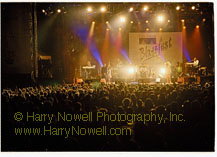Exposed! :: Inter-Galactic Light: a Guide to Effective Lighting ::© Copyright 2007. All Rights Reserved. Contents In the photography world, light is one of our most fundamental tools. We observe and manipulate how light falls on film and digital sensors to create pictures. Most photographers use the sun as their main source of light. It is powerful and offers qualitative variations - diffused lighting on a cloudy day, harsh midday sun, rich golden hues of sunset. But light itself is a fascinating subject that goes far beyond the natural, nuclear source from the sun! In this month's edition of Exposed! we visit interesting light opportunities from Ottawa's Bluesfest music festival and a photography workshop involving an international fireworks competition!
What is light?Different light can create different effects depending on whether the light source is:
Light is measured using the Kelvin temperature scale. Normal daylight registers at about 5500 Kelvin degrees whereas light diffused through clouds is a little cooler. Huh? What does this mean? White balanceWe will leave the physics to the physicists! For the purposes of Exposed! I will say, depending on the source, light produces different visual effects. This can result in yellow, blue or even green casts in your pictures. To help accurately capture colour in pictures, digital cameras have a built-in "white balance" feature. This function helps keep whites white and the hues of the rest of the colour spectrum consistent. Film users can make similar corrections but achieve the results differently by using tungsten film or filters to help create a scene with true colours. HomeworkYour homework this week is simple! Set your white balance to manual or load a roll of regular (daylight balanced) film. Choose a multi-coloured, moveable object - perhaps a teddy bear, cushion, etc. - and photograph it under different light sources:
How does your teddy bear change? Do you like the different effects?
What if...Sometimes rules are made to be broken! Try deliberately using an incorrect white balance setting or load tungsten film under normal light conditions. Conversely, try photographing under artificial light conditions without compensating. This is where things start to get fun! Fireworks use pyrotechnical wonders that light up the night sky. The creative light potential in fireworks photography is huge! How do you compensate for the brilliantly diverse and ever-moving lights? Practice and experimentation helps! Take your camera and tripod to a fireworks display and keep your fingers crossed. You can also take the Fireworks Photography Workshop to fast-track your results at an annual international fireworks competition! Pro PerspectiveI have had the pleasure to work at Ottawa's Cisco Systems Bluesfest capturing the excitement, performances and spectacular stage lighting of one of the finest music festivals in North America. Having an understanding of light (artificial and stage lighting) with respect to photography has been important when shooting such an event. My Bluesfest work has been used in Canada, Europe and three prominent US newspapers ... I do enjoy my work! Bluesfest is a fun, accessible place to experiment with colour temperature and varied, mixed and artificial lighting. With many stages and shows running for twelve days and nights this outdoor music festival will keep your cameras clicking and ears happy! Final FrameKeep your eyes open and do not adjust your set. Take a look around and start noticing the different opportunities for fun with funky lighting. Observe, experiment and consider a Fireworks Photography Workshop if you want to really trip the light fantastic. Take photos. Have fun! Like the article? Digg it and spread the word! |
Samples |


